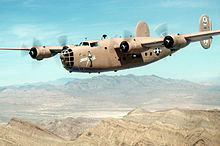- Little Eva (aircraft)
-
"Little Eva"
Consolidated B-24D Liberator similar to "Little Eva"incident summary Date 2 December 1942 Type fuel exhaustion Site Near the Gulf of Carpentaria
17°20′1″S 139°00′3″E / 17.33361°S 139.00083°ECoordinates: 17°20′1″S 139°00′3″E / 17.33361°S 139.00083°ECrew 10 Fatalities 7 (2 in crash) Survivors 3 Aircraft type Consolidated B-24 Liberator Flight origin Military base in Iron Range National Park Destination Military base in Iron Range National Park "Little Eva" was a USAAF Consolidated B-24 Liberator which, after a bombing mission, got lost and crashed after exhausting its fuel supply on 2 December 1942 north-west of Burketown, Queensland (near the Gulf of Carpentaria).
The crew had taken to their parachutes before the crash. The survivors, now in two groups, set out on foot. Two of the crew travelled east and reached civilisation after twelve days. The other party travelled westerly, with the only surviving member being found some five months later.
Contents
Crash
The plane, part of the 321st Squadron, 90th Bombardment Group based at Iron Range was returning with four other B-24s from a bombing raid on a Japanese troop convoy about 80 km north of Buna, Papua New Guinea. "Little Eva" lost touch with the other planes and returned to the base on its own. A severe thunderstorm disabled the radio, causing the flight to lose its way and run out of fuel. Lieutenant Norman Crosson, the pilot, gave orders to bail out. Most of the crew members parachuted to safety but one was killed when his parachute snagged on the airacaft and another who did not jump was killed when the plane crashed at about 2:45am near the Burriejella waterhole.
Survival
Although the crew had been instructed to convene at the crash site, only Crosson and Sergeant Loy Wilson arrived there. The other survivors had decided to head for the coast about 24 km (15 mi) away. Both groups of survivors believed they were on the east coast of Cape York Peninsula and close to Cairns.
Crosson and Wilson had extremely little food and water. They walked east to what they felt should be the east coast of Cape York and quite by chance this route took them almost straight to Escott Station, 15 km west of Burketown, where they arrived after a trek of some 60 km on 14 December 1942. Exhausted and with badly blistered feet, they were driven to the four-bed Burketown hospital for medical attention and flown back to Iron Range a week later. Their rescue sparked a search for the other men which would continue for some five months. The missing men were Staff Sergeant Grady Gaston, 2nd Lieutenant Arthur Speltz, 2nd Lieutenant Dale Grimes, 2nd Lieutenant John Dyer, and two other unaccounted crew members. Their resources consisted of two .45 calibre pistols, a few bars of chocolate, a jungle knife, a fish hook and line, and some matches.
After the crash Gaston's party travelled in a westerly direction until they reached the Gulf of Carpentaria and then followed the shoreline. They were fortunate enough to shoot a young bullock on their fourth day out, gorged themselves on as much meat as they could and pressed on. Concerned about carrying unnecessary weight, they took no meat with them. A day later they discarded their pistols as being rusty and useless. Heading north-west along the beach, they were forced to swim across a number of rivers—managing to avoid the crocodiles common in those waters.[1]
Search and rescue
On 15 December 1942 a large search party consisting of seven men of the North Australia Observer Unit (NAOU), fifteen Volunteer Defence Corps (VDC) members, a local policeman and two aborigine trackers set out out from Escott Station to find the crash site.
The officer heading the search was Lieutenant Stan Chapman of the NAOU and he made his headquarters at Burketown. Five days into the search he enlisted the help of Ian Hosie, a Flying Doctor and soon located the wreckage. Here they found six parachutes and two charred corpses which they buried at the site. Lieutenant Frank Comans of the NAOU set out with a small party to follow the tracks of the survivors. This they managed to do for more than 130 km. The wet conditions made for difficult tracking particularly at stream crossings and the trail was finally lost at Settlement Creek near the border between Queensland and Northern Territory.
The survivors found a shack on 24 December where they made a base. Grimes, the bombardier, was drowned in Robinson River when the current took him out to sea and he was too weak to swim back. His body was later recovered. Lt Dyer died on 10 February and Speltz (co-pilot) in the night of 24/25 February. Grady Gaston, the ball turret gunner, was rescued on 23 April 1943 when he was discovered by ranchers looking for stray cattle and taken over time to Cloncurry. From there he was collected by the USAAF on 11 May.
Documentary
In 1988, Les Hiddins visited the crash location and filmed the wreckage as part of his Bush Tucker Man show (series 1, episode 7). In 1994, Film Australia produced a one-hour documentary about the crash called Aeroplane Dance.
References
External links
Categories:- Aviation accidents and incidents in Australia
- Aviation accidents and incidents in 1942
- 1942 in Australia
Wikimedia Foundation. 2010.

